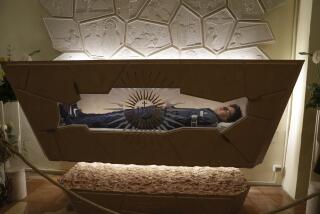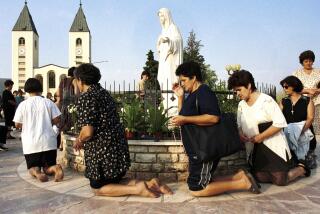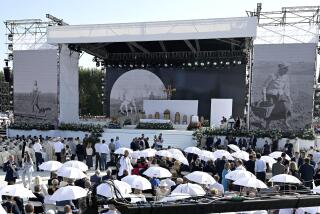John Paul II’s fast track to sainthood
- Share via
The Roman Catholic Church has either a very good or a very bad sense of humor. The Vatican has announced that the late Pope John Paul II will be beatified on May 1. Beatification, which requires church certification of a miracle by the would-be saint, is sort of a halfway house on the way to full sainthood, which takes two miracles. JP2’s beatification, if it proceeds as scheduled, will have been the fastest on record — six years, from death to finish, edging out the previous record holder, Mother Teresa, by just a few days.
When JP2 died in 2005, 3 million people at the funeral chanted “Santo subito!,” or “Sainthood now!” (not unlike at Richard Holbrooke’s funeral in Washington last week). But rules is rules, as nobody knows better than the Catholic Church. JP2’s successor, Pope Benedict XVI, waived the traditional requirement of a five-year waiting period before the process can even begin. But he could not waive the main requirement — those pesky miracles.
Some might consider bringing down the Soviet Union something of a miracle. Or maybe running the best school systems in America. But that’s not what the church means. It demands an old-fashioned, abracadabra type of miracle, such as appearing as a vision before a Catholic businessman as he is about to perform an act of illegal insider trading, or ridding an entire major sports team of athlete’s foot.
In this case, JP2 wasted no time. Once he got to heaven, he immediately got to work. He hadn’t been dead long when he answered the prayers of a French nun, curing her of Parkinson’s disease. You thought Parkinson’s was incurable? So did I. And I have it, as did JP2 in his last years. But apparently not — if you know whom to pray to. Sister Marie Simon-Pierre of the Congregation of Little Sisters of Catholic Maternity Wards requested JP2’s intercession, and lo and behold she woke up one morning, two months after the pope had died, to discover that all of her symptoms were gone. According to the Associated Press story, she remains symptom-free today — no more trembling hands, no stumbling walk.
Of course, there is another possibility besides a miracle: Maybe she never had Parkinson’s in the first place. There is no way to diagnose Parkinson’s for sure; you just eliminate other possibilities — such as a brain tumor — until Parkinson’s is the last malady standing, and often a welcome one, considering the alternatives. But, according to AP, “Vatican-appointed doctors” determined that “her cure had no scientific explanation.” That sounds bad, but actually it’s good. If there’s no scientific explanation, the explanation must be unscientific — in other words, a miracle. There’s nothing like a scientific explanation to spoil everything. Fortunately, none materialized. Therefore, the Vatican doctors concluded, it was a miracle. One down, one to go.
Congratulations to Sister Marie Simon-Pierre. It’s miraculous what a miracle can do. But I could use a miracle cure for Parkinson’s too, as could millions of others around the world who have Parkinson’s or will develop it. And one of the main impediments to such a miracle is the Roman Catholic Church. The most likely source of miracle cures for all sorts of diseases, with Parkinson’s foremost among them, is stem cell research. The church opposes stem cell research on the grounds that it uses, and in the process destroys, human embryos. These are surplus embryos from fertilization clinics that will be destroyed, or permanently frozen, anyway. They are not fetuses; they are clumps of a few dozen cells.
But of course none of this matters if you believe they are full human beings like you and me. The famous test of that belief goes something like this: Suppose there was a fire destroying your house and you had the choice of rescuing either one real 1-year-old baby or two test tubes containing an embryo each. Would you really go for the test tubes and let the baby die?
It seems more than a little unfair (not characteristic of John Paul II at all) that he should cure this nun but leave the rest of us hanging out to dry. I hope that, in his next miracle, he will do something to rectify this situation. After all, it might be his last one.
Michael Kinsley, former Editorial Page and Opinion editor of this newspaper, writes a column for Politico.
More to Read
Sign up for Essential California
The most important California stories and recommendations in your inbox every morning.
You may occasionally receive promotional content from the Los Angeles Times.










